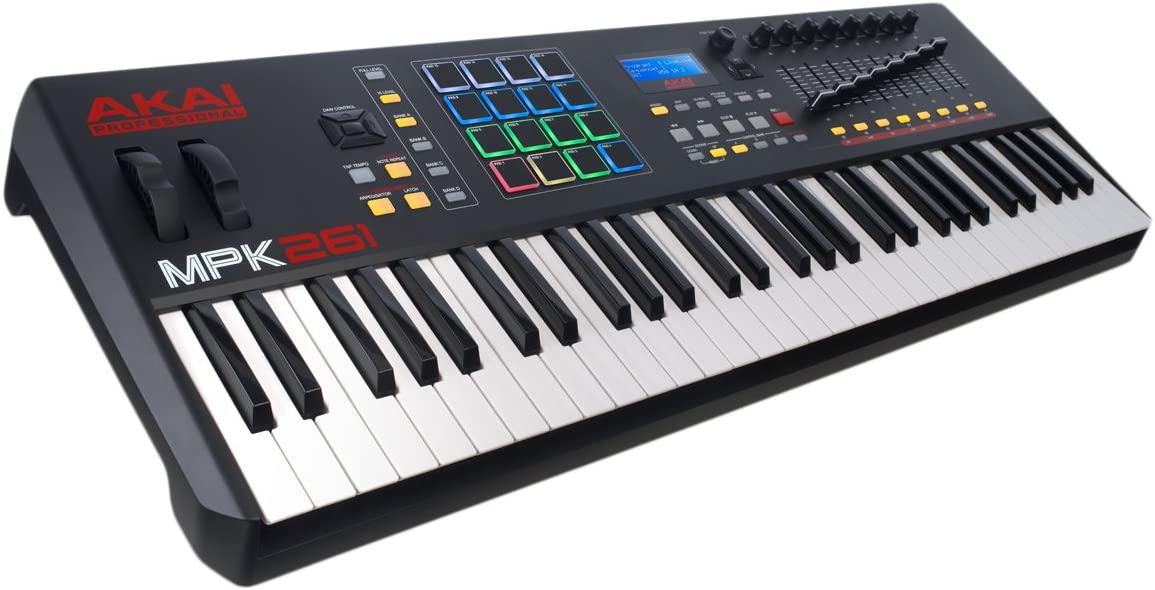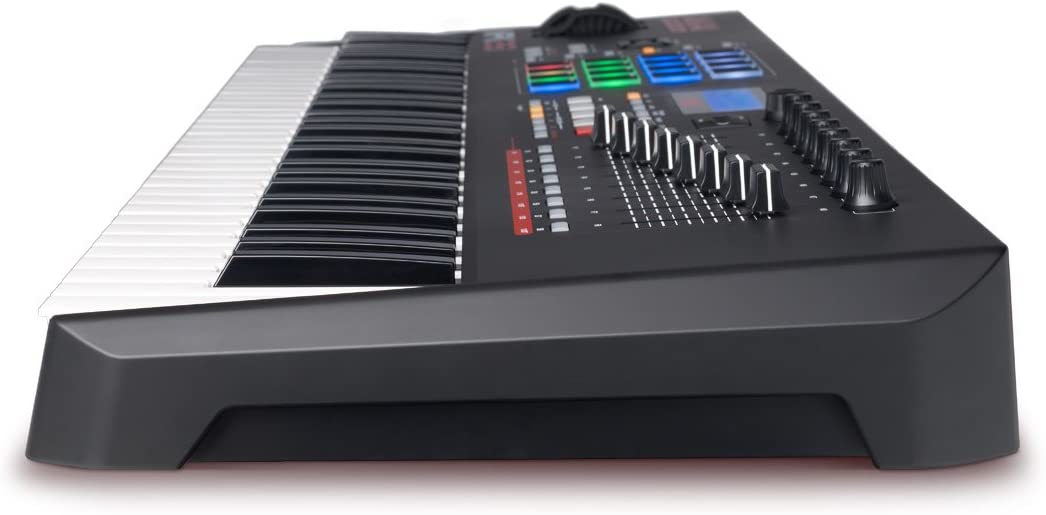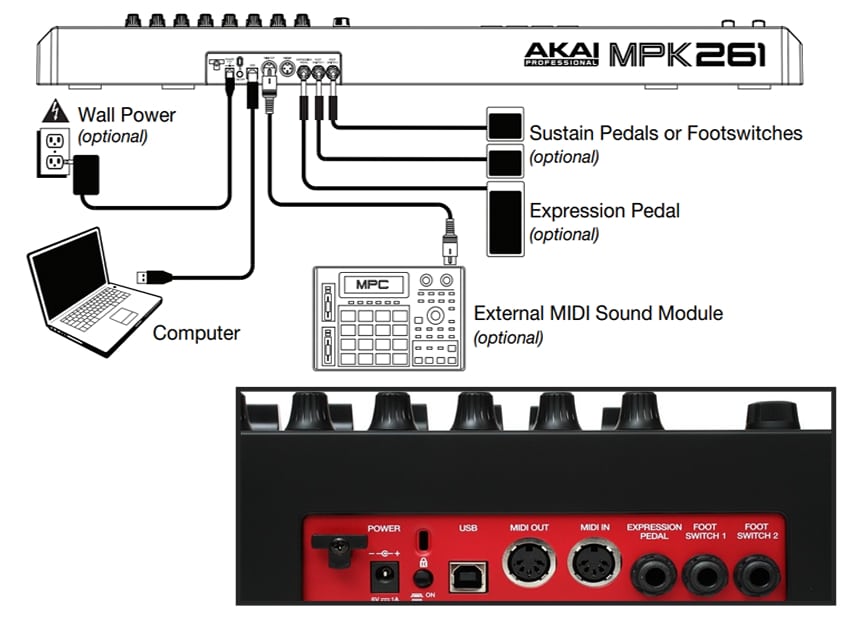










Akai MIDI keyboards have generally been considered some of the best in the market. This is due to their functionality but is also helped along quite nicely by the ease of their integration with DAWs, including the Ableton Live. The latter ensures that they could provide the kind of premium service required by musicians during live performances.
This Akai MPK261 review shows how this MIDI controller delivers on the expectations set by the reputation of its manufacturers. Where some 61-key MIDIs might come out looking burly and poorly designed, this Akai has a well-designed exterior that is capped out by a sensible layout of its features, allowing for easy access to all it has to offer.
| Number of keys | 61 |
|---|---|
| Pads | 16 MPC-Style with RGB Feedback |
| Assignable knobs | 8 |
| Controllers | 24 |
| Connectivity | Plug-and-play |
| Software | Ableton Live Lite, Hybrid 3 by AIR Music Tech and SONiVOX Twist 2.0 |
| Interface | Customizable |
| Dimensions | 12.28 × 36.65 × 3.39 inches |
| Weight | 16.1 lbs |
The advantages of a 61-key MIDI keyboard have been well documented. They allow for more functionality and expression than the smaller keyboards and can be transported more easily than an 88-key controller. The Akai MPK261 inevitably brings those advantages to your table but adds to it expressive pads, access to, and the ability to use many of the major DAWs available on the market. Its compatibility with both ios and windows devices also makes it a fan favorite. Finally, as with all popular products, a fair price rounds up this MIDI keyboard that would make an excellent addition to the table of any aspiring musicians and pianists.
The Akai MPK261 has largely lived up to the hype that surrounded its release and has capably delivered for the customers that have purchased it. The success of this MIDI keyboard Trusted Source MIDI - Wikipedia MIDI’s appeal was originally limited to professional musicians and record producers who wanted to use electronic instruments in the production of popular music. The standard allowed different instruments to communicate with each other and with computers, and this spurred a rapid expansion of the sales and production of electronic instruments and music software. This interoperability allowed one device to be controlled from another, which reduced the amount of hardware musicians needed. MIDI’s introduction coincided with the dawn of the personal computer era and the introduction of samplers and digital synthesizers. The creative possibilities brought about by MIDI technology are credited for helping revive the music industry in the 1980s. en.wikipedia.org has been documented and reported on as seen in customer reviews, with many pleased customers specifically praising its keys and functionality given its price. It also helped that the keyboard came with a couple of software, making it more appealing.
A very big criticism of keyboards as training wheels for dealing with pianos has always been the inadequacy of their weightless keys to compare with those of pianos. Along with that, smaller keyboards have been accused of not providing enough room for a two-hand experience to benefit players.
The MPK261 does away with such criticisms, as it is a 61-key keyboard (large enough to accommodate two hands more than comfortably) and one with semi-weighted keys as well. The semi-weighted keys might not be as good as fully weighted keys, but they bridge the gap between the piano experience and the keyboard experience to some extent.
It also helps that the keys of this keyboard come with aftertouch functionality to help control and modify vibrato and volume when a key is played. This is in addition to the bells and whistles that more keys would allow for.
Considering that Akai Professional (manufacturers of this keyboard) were the first keyboard manufacturers to use pads as controllers, the Akai MPK261 has consolidated on the company’s commitment to expressive pads.
As such, this MIDI controller has been fitted with 16 RGB lit pads that each possess four banks, consequently providing users with a wide variety of samples that can be triggered in real-time to spice up performances or for use during recordings.
These pads join the modulation wheels, pitch bend, octaves as well 8 faders, knobs, and switch each to grant users of the keyboard a significant amount of control over their music and the ability to express themselves fully.
This keyboard was expected to provide more measure of control, and it doesn’t fail to deliver with eight assignable knobs part of the hardware. The functions of the individual knobs vary, but they allow for control as they are meant to and with little chance of errors due to complications and mistakes.
While many modern MIDI keyboards might be able to boast of only the more popular USB ports that allow connection with the corresponding connector cable, the Akai MPK261 also allows for connections via a 5-pin MIDI as well, as it has MIDI ports Trusted Source Home Recording Basics: MIDI Ports - dummies MIDI is a protocol that musical instruments use to communicate with one another. They do this through a cabled connection and a language that allows each one to understand the other, regardless of the manufacturer or instrument. www.dummies.com for this purpose. This means that there might be no need for a converter at all.

As we earlier stated, the Akai MPK261 has been constructed and made with mappings that enhance its functionality with many popular DAWs. However, this keyboard has been well-publicized and applauded for performing its best with arguably the best DAW on the market, the Ableton.
The ability of the keyboard and DAW to mesh is because both have been designed after the same philosophies thus, making them inherently favored for integration with one another. In addition to all of the compatibility offered by the MPK261, it also comes along with its bundle of software upon purchase, including the Ableton Live Lite and SONiVOX Twist 2.0.
The interface is just what you’d expect from a quality keyboard in this price range. The Akai MPK261 possesses an LCD screen that allows users to select and navigate through available presets. The screen also lets users send out regular keyboard-style commands to computers. All of this dovetails nicely with the generally fair arrangement of the knobs, faders, and pads that allow for easy access to all of the keyboard’s features.
Brands like this do not become so popular on the back of poorly durable products, and the popularity of the Akai keyboards should be evidence itself of the durability and longevity of their products. Further proof of that should be the 6-year warranty policy that accompanies a purchase of this keyboard. There’s also a money-back guarantee of 180 days.
The price of this Akai has been one of the many sources of problems with potential customers, but we can’t see why. The MPK261 is on offer for about the same price as one of its predecessors (the Akai MPK61) was after its release. That is, even though a couple of tweaks have been made to improve its operation (compared to the MPK61), and a bundle of software that is almost equivalent to its retail price has been added. If anything, this is a good deal; it might not be for some players looking to improve on certain MIDI keyboards, but for musicians looking for a quality 61-key MIDI to aid their production, it is.
The functionality and quality of this keyboard are not up for debate, and this should be very obvious by this point. A simple summary of its features should press home that point further.
|
PROS |
CONS |
|
|
The MPK series of the Akai keyboards have always been accused of simply repackaging the same hardware, and that is partly true, but the gold in them happens to be the subtle changes that are usually made to their functionality with each new release.
This Akai MPK261 review should prove beyond a doubt that despite this ‘repackaging,’ the price that is being paid for this keyboard (especially considering the software bundle it comes with) is a cheap one.
Rather than missing out on a good deal because of the fear of being cheated, purchase this keyboard to receive worthwhile service at an affordable cost.